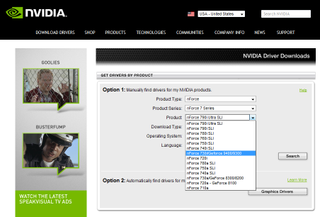G45 And GeForce 9400: Integrated Chipsets For Core 2
Nvidia GeForce 9400 mGPU
The GeForce 9400 mGPU is based on the GeForce 9300 chipset, which we reviewed in the fall of 2008. It is based on the G86 core (GeForce 8400 GS), which means that there are 16 unified shaders. The only difference between the GeForce 9300 and the 9400 is clock speed: there is a 450 MHz core clock and 1,200 MHz shader clock for the GeForce 9300 mGPU, while the 9400 speeds up to 540 MHz core and 1,400 MHz for the shaders. Needless to say, this is sufficient horsepower to translate into a nice advantage over Intel’s offering.

Chipset Features
Although Intel’s G45 consists of the classic two-chip layout (northbridge and southbridge) and Nvidia decided to build a single-chip solution, their technical characteristics are similar. Bus speeds of up to FSB1333 are supported, as are all Core 2 processors including the Extreme Editions this time. Once again, these have to be supported by the particular motherboard, due to the high power requirements.
One x16 PCI Express slot will accept a gamer’s dedicated graphics board if he or she gets tired of the integrated unit’s performance. Other features, including 12 USB 2.0 ports, 6 SATA/300 drives with AHCI and NCQ plus RAID support, five 32-bit PCI 2.3 slots, HD audio, and Gigabit networking, can be found on any product starting at the lower mainstream.
Nvidia Features

There are some good reasons why some users might prefer the Nvidia GeForce 9400 chipset over the G45, despite Intel’s tradition of providing reliable and stable platforms. On the one hand, there is GeForce Boost, which allows plugging in an additional GeForce 8400 GS or 8500, and running it in Hybrid SLI mode, teamed up with the on-board solution. Hybrid Power, which is supposed to shut down graphics cards that aren’t used, didn’t work on our test sample, and it was mentioned as “only available in select designs” in Nvidia reviewer’s guide (Ed.: It's worth noting that this feature is, for lack of a better word, dead following the release of Nvidia's more energy-efficient GeForce GTX 260 and 280 GPUs).
On the other hand, there is the option to utilize Nvidia’s 16 unified shaders and their floating point performance to accelerate applications that were adjusted to take advantage of CUDA or PhysX. CUDA is Nvidia’s effort to bring parallel processing to mainstream applications, while PhysX is very much self-explanatory: it is about delivering more realistic physical environments in games and other simulations of reality, by utilizing the GPUs’ processing power in games optimized for the API.
Stay on the Cutting Edge
Join the experts who read Tom's Hardware for the inside track on enthusiast PC tech news — and have for over 25 years. We'll send breaking news and in-depth reviews of CPUs, GPUs, AI, maker hardware and more straight to your inbox.
PureVideo HD
Nvidia claims that 100% of the decoding workload (HDCP and video) can be offloaded to its GPUs, which we found to be very close to correct. Although we used quad-core processors, the CPU load was well below 10% at all times. Intel’s chipset showed increased CPU load on the slower test CPU, while the systems running the GeForce 9400 mGPU remained almost at the same level.

The only really confusing thing was our attempt to download the latest drivers, which can be found neither in the GeForce nor nForce 8/9 sections. Instead, you have to select nForce—which alone may be impossible for someone who is not familiar with the Nvidia portfolio—check nForce 7 series and then select nForce 730i/GeForce 9400/9300.
Current page: Nvidia GeForce 9400 mGPU
Prev Page Intel Desktop Board DG45ID Next Page DFI LANParty GF9400-T2RSMost Popular


